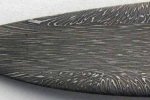- Joined
- May 9, 2000
- Messages
- 29,205
I have just noticed something about a convex edge on a damascus blade that I really like. The pattern of the damascus goes all the way to the very edge. This is something that I find very appealing. I am sure that many others have noticed this in the past and it is not news to most, but it was a new discovery for me.
On a beveled edge the pattern is only noticeable up to the edge of the bevel and is not easily visible, if visible at all, in the beveled edge. The reason for this is that etchant is corrosive and it desolves the different steels (and nickel, if pure nickel is used) at differnet rates. This leaves many hills and valleys in the blade. When polished the valleys remain dark and the hills become shiny (the pure nickel stays shiny all the time). When you grind away the bevel for the edge, you remove these hills and valleys and there is no longer any dark and light areas that make it easy to see the pattern welds. When a convex edge is used, this doesn't happen.
Ok, so this is not earth shattering news, but it has educated me and made a difference in the type of edge I will want on all my damascus blades in the future. Before it would not have mattered to me; now it will have to be a convex edge.
On a beveled edge the pattern is only noticeable up to the edge of the bevel and is not easily visible, if visible at all, in the beveled edge. The reason for this is that etchant is corrosive and it desolves the different steels (and nickel, if pure nickel is used) at differnet rates. This leaves many hills and valleys in the blade. When polished the valleys remain dark and the hills become shiny (the pure nickel stays shiny all the time). When you grind away the bevel for the edge, you remove these hills and valleys and there is no longer any dark and light areas that make it easy to see the pattern welds. When a convex edge is used, this doesn't happen.
Ok, so this is not earth shattering news, but it has educated me and made a difference in the type of edge I will want on all my damascus blades in the future. Before it would not have mattered to me; now it will have to be a convex edge.



